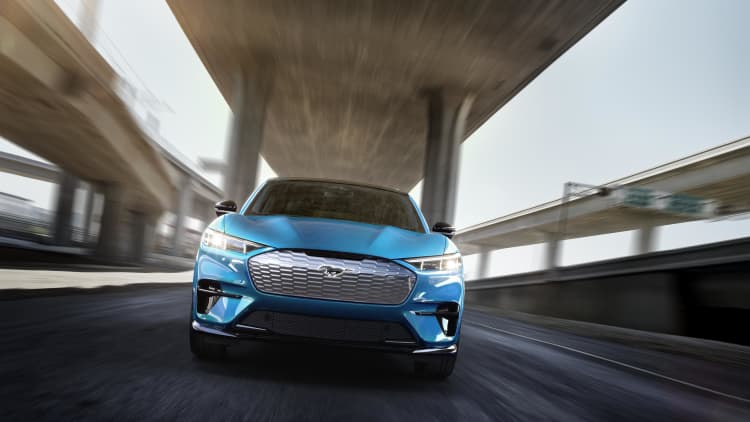[ad_1]

DETROIT – General Motors’ future may be in all-electric vehicles, but it still needs its current models to pay the bills to allow it to invest in those new products.
That’s one of the reasons why the automaker on Tuesday revealed the 2024 Chevrolet Corvette E-Ray – the first-ever “electrified,” or hybrid, version of the famed sports car. It also features all-wheel drive, another first for the eighth-generation, or C8, Corvette.
The car – starting at about $104,000 when it will be released later this year – may surprise some consumers, as it’s a step toward full electrification but a unicorn in GM’s lineup. The Detroit automaker had discontinued all hybrids, including plug-in hybrids, to focus investment on all-electric vehicles.
So why make a hybrid Corvette? GM says there are several reasons but, in general, the automaker was already developing the technology ahead of its more aggressive EV ambitions. It’s also a new market for that should help the company test the waters of electrification for the iconic car.
“It’s just a new market opportunity for us as a company to showcase our engineering and our development of the whole architecture of C8 does,” GM President Mark Reuss told CNBC’s Phil LeBeau. “General Motors and Chevrolet keep increasing what we’re delivering for the Corvette customer.”
Reuss last year confirmed an all-electric Corvette is coming, but GM has not announced timing for the EV version.
It’s a Corvette
The most obvious reason for the hybrid is it’s a Corvette, so GM does special things for it. The car has been a halo vehicle for the automaker for 70 years. It’s something the company has always considered to be in a class of its own, with the capability of attracting new buyers to the company overall.
The current eighth-generation car is especially notable because GM made it into a mid-engine sports car for better performance, moving the engine from under the hood to behind the two passenger seats of the car.
2024 Chevrolet Corvette E-Ray hybrid sports car
GM
The C8 features an exclusive Corvette engine and architecture. Almost every GM vehicle shares platforms, engines and other features. For example, all of GM’s full-size trucks and SUVs are on the same platform and largely feature the same engines.
“There’s just an incredible architecture beneath it, and the architecture was planned and engineered for quite a few variants,” Reuss said.
The last GM vehicle to use a modified Corvette architecture was the sixth-generation version, with the short-lived Cadillac XLR, which was discontinued in 2009.
Capital spent
Officials also say the hybrid was developed in conjunction with the regular C8 Corvette, which debuted in July 2019.
That means most, if not all, of the capital for research and development of the car was allocated prior to GM’s accelerated EV plans. The Corvette plant in Kentucky also will not need any additional investment or downtime for the change, according to a GM spokesman.
2024 Chevrolet Corvette E-Ray hybrid sports car
GM
“It’s just part of our journey to what we have talked about before that there are ‘electrified’ and then fully electric Corvettes, and we’re certainly on the road to that,” Steve Majoros, vice president of Chevrolet marketing, said during a media briefing. “But in the meantime, we have a lot of technology bandwidth that we can still unpack with Corvette.”
The hybrid system was specifically designed for the eighth-generation Corvette, according to Harlan Charles, Chevrolet Corvette product marketing manager. The battery system – a 1.9 kWh battery pack that’s located between the seats – is charged mostly via regenerative energy from coasting and braking, as well as during normal driving.
The system allows the Corvette to start quietly instead of issuing the sound of the roaring V8, improves acceleration and, potentially, the vehicle’s fuel economy. GM declined to release mpg expectations, which for the regular C8 is 19 mpg combined.
Corvette family?
Future all-electric Corvettes may change more than just the vehicle’s powertrain. Automotive News, citing industry forecasters, last year reported GM is expected to debut an all-electric SUV version of the Corvette around 2025.
A Corvette SUV has been speculated about for years following the success of other sports car manufacturers such as Porsche, Maserati and others successfully expanding into such vehicles. Ford Motor also has found success by utilizing naming, badging and characteristics of its Mustang for the all-electric Mustang Mach-E.

Ford has gone as far as saying the Mach-E is the reason the carmaker can continue to produce V-8 versions of the car. GM could do something similar.
The GM spokesman declined to speculate on expanding Corvette, citing the company has seen the reports and will “not engage in the speculation.”
In late 2019, Morgan Stanley analyst Adam Jonas said a Corvette sub-brand could be worth $7 billion to $12 billion for the automaker.
No plug-in
GM’s Reuss has made it clear that the company is not interested in plug-in hybrid electric vehicles since it discontinued the Chevrolet Volt in early 2019. He has described such vehicles as too costly to produce and as transitional in the push to all-electric cars and trucks.
“There is no plug-in piece of this,” Reuss said. “This is a truly performance-oriented electrified system.”
2024 Chevrolet Corvette E-Ray hybrid sports car
GM
Aside from the company giving up on PHEVs, officials said the extra weight of additional batteries and plug-in technologies would drag down the vehicle’s performance. An all-electric Corvette would be heavier but benefit from the nearly instantaneous torque and other EV driving dynamics to offset the weight gain.
“The mission of this vehicle was performance, performance, performance,” said Mike Kociba, lead Corvette development engineer. “Every kilogram or pound had to earn its way in from a mass standpoint. … It hurt performance, plain and simple.”
– CNBC’s Phil LeBeau contributed to this report.
[ad_2]
Source link
